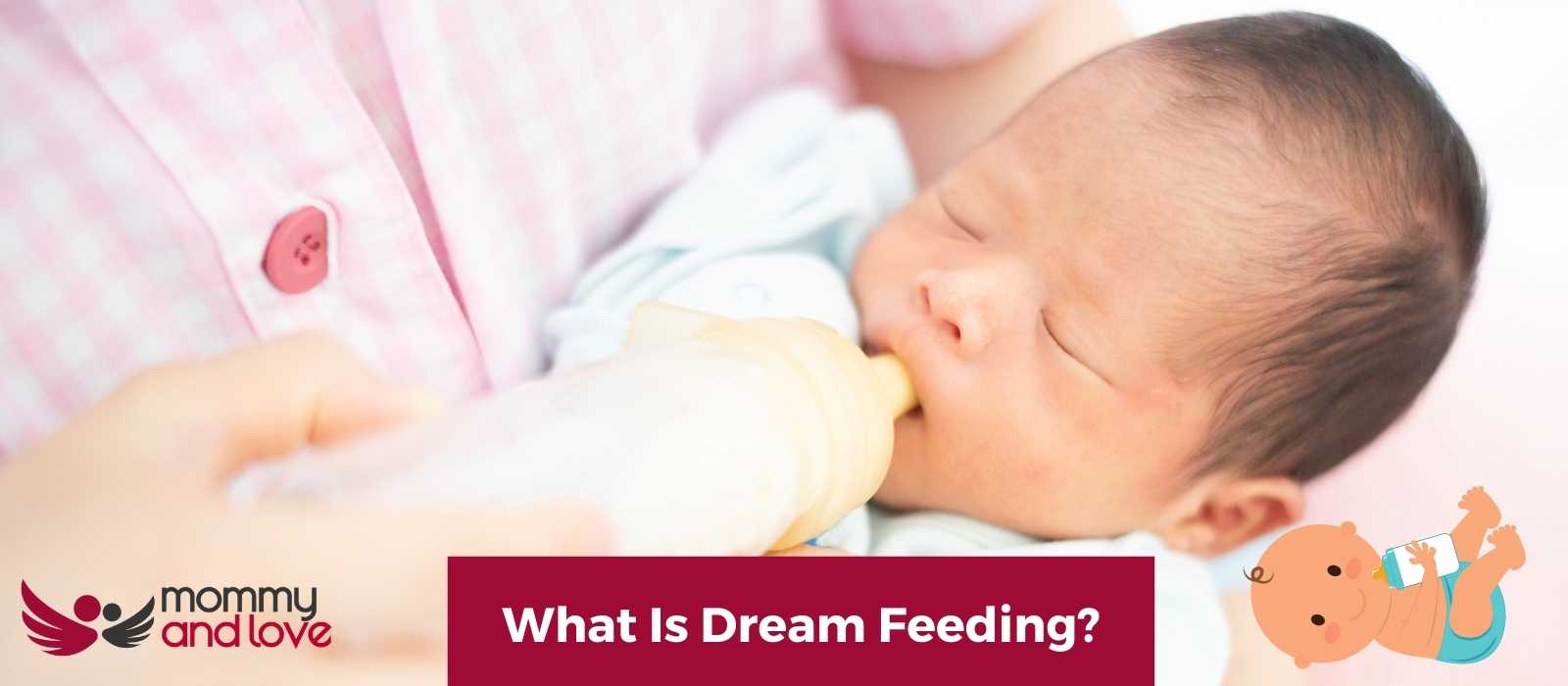If you’re trying to get your baby to sleep through the night, you might have come across the term dream feeding.
Dream feeding is the practice of feeding a baby while they’re in a dreamy state or semi-awake. Usually, parents wait for their newborn babies to signal that they’re ready to be fed. But when you dream feed your baby, you will be the one who will initiate the feeding.
Dream feeding can be beneficial for both baby and parents. Babies who dream feed tend to have longer stretches of sleep at night, which means parents get more rest too!
What Is a Dream Feed?

A dream feed is a late-night feeding that you give your baby shortly before you go to bed, usually two or three hours after you’ve put your baby to sleep.
It’s the parents that initiate dream feeds, not the young babies.
Dream feeding includes initiating feeding while the baby is sleeping or is semi-awake before the parent falls asleep. Giving your baby a late feeding may fill him up enough to allow him to sleep for a longer period of time overnight, allowing you to get more sleep and defeat sleep deprivation.
The concept is that if you dream feed your baby without fully awakening them before going to bed, they will be full enough to enjoy a longer stretch of uninterrupted sleep at night and/or till early morning, potentially avoiding waking up in the middle of the night or early hours of the morning.
Typically, parents would initiate a dream feed between 10 p.m. and midnight. Parents select the time of the dream feed based on when they go to bed and what appears to work best for their baby.
Do Dream Feeds Help Babies Sleep?
But does dream feeding work? Like everything, it depends! Usually dream feeding works and can help babies sleep, but not always.
For most babies over 4 months, the first part of the night is the deepest sleep of the night. As a result, it may be difficult to rouse your baby properly to feed whenever you want.
Some babies will wake up just enough to feed and sleep, while others may not wake up enough or wake up too much. They may be annoyed that you woke them up, especially if they aren’t hungry.
When dream feeds don’t work, they usually happen when your baby still wakes up two hours after feeding her before you turn in for the night. It could be worse if your baby doesn’t go back to sleep after waking up.
Dream feeds appear to be especially beneficial for babies under 6 months old, who may still require many night feedings.
Some babies may wake up more frequently after the first-night feeding, so the dream feed has the opposite effect intended and might be messing with your baby’s natural sleep cycles.
Of course, you can always give dream feed a try for a few nights and see if it works for you and your baby. If doing it leads to a more rested baby, continue doing it until it’s no longer needed.
Sample Dream Feeding Schedule
Here’s what your schedule would look like if you dream feed.
| 6:30 PM | Your baby’s schedule for bedtime feeding and other bedtime routines. |
| 7:00 PM | Your baby goes for his nighttime sleep with a full tummy. |
| 10:00 PM | You dream feed or offer another full feeding to your baby. Usually, this will be the last feed of the day. |
| 10:30 PM | You go to bed after filling up your baby’s tummy. |
| 3:00 AM or 4:00 AM | Your baby wakes up for her usual night time feed. |
| 3:30 AM or 4:30 AM | Your baby goes back to sleep. |
| 7:00 AM | Your baby wakes up to start his day or goes back to sleep for another hour or two. |
What Are the Benefits of Dream Feeding?
Here are some of the benefits of a dream feed.
- Dream feeding is a way to line up your baby’s longest stretch of sleep with your first chunk of sleep. This can provide some benefits for both you and your little one.
- Dream feeding is a practice that ensures bottle-fed and breastfed babies get enough calories, without risking them developing sleep associations.
- When you dream feed and you’re a breastfeeding mom, it helps you maintain your breast milk supply, without the need for extra pumping sessions to have enough milk.
- A dream feed helps you anticipate the times of your baby’s night wakings thus eliminating any guesswork for night time feeds.
- When dream feeds work, they offer parents a couple more hours of sleep which is always beneficial.
What Are the Risks of Dream Feeding?
Dream feeding is when you feed the baby while she doesn’t fully wake. It can be done with breastmilk or formula.
There are some risks associated with dream feeding, including:
A Dream Feed Might Interrupt Your Baby’s Sleep.
Dream feeding can actually interrupt your baby’s sleep. If you are dream feeding, you are likely waking them up in order to do so. This can lead to more night wakings and less overall sleep for your baby.
It Is Not Safe to Dream Feed a Baby Who Is Completely Asleep.

It is not safe to dream feed a baby who is entirely asleep or lying down on their back. This is because they could choke on the milk or formula.
If you are going to dream feed your baby, make sure they are in a semi-awake state so they can swallow properly.
A Dream Feed May Lead To Overfeeding.
If you are not careful, dream feeding can lead to overfeeding. This is because you are likely feeding your baby more than they need since they are half-asleep. It is important to pay attention to your baby’s cues and only feed them as much as they want.
A Dream Feed May Cause Digestive Issues.
Dream feeding can also cause digestive issues for your baby if they are not used to it. If you start dream feeding the baby, pay close attention to their stool. If they have more diarrhea or constipation than usual, it is best to stop dream feeding.
A Dream Feed Might Cause Gas and Bloating.
Dream feeding can cause gas and bloat in your baby. This is because they are swallowing air while they are half-asleep. If you notice that your baby is especially gassy after dream feedings, it is best to stop.
If Not Done the Safe Way, a Dream Feed Can Lead to Middle Ear Infections.
Dream feeding your baby while they are lying down on their back can also cause milk to run into the Eustachian tubes in their ears. This can lead to a middle ear infection. If you notice that your baby has an ear infection, stop dream feeding and see your doctor.
It’s better to be aware of these risks and drawbacks to dream feeding before you start doing it. Ultimately, the decision to dream feed or not is entirely up to the parents.
When to Start Dream Feeds for Your Baby?

Many parents swear that the practice of dream feeds really helps and they often start dream feeding their baby between 6-8 weeks and 4 months (past the newborn stage).
Around this time, most babies are able to sleep for longer periods of time at night and don’t need to be fed every 3 hours.
Before you start dream feeds, make sure you see what your baby’s temperament is and what his night time pattern usually looks like.
How to Dream Feed
Dream feeding is a great way to help your baby sleep through the night.
- To dream feed, try to time it when your baby is in REM sleep.
- To breastfeed or bottle-feed your baby, place the breast or bottle near your baby’s mouth and wait for them to latch on.
- To maximize sleep, time a dream feed to occur between 10 and 11 p.m. This will also help get your baby sleeping through the night.
- To get a baby to wake up, try gentle movements and sounds.
- After your baby is done dream feeding, put him back to sleep in his crib, on his back, and try to burp him.
- If you notice a wet diaper, change your baby’s diaper before putting him back to sleep.
- Don’t forget to do the wake and sleep trick to teach your babies to fall asleep on their own.
Conclusion on Dream Feeding
Ultimately, the decision is up to the parents. There are associated benefits and risks with dream feeding, so it’s important for parents to weigh these carefully before making a decision.
If they decide that dream feeding is right for their family, then following some simple tips can help make the process go smoothly.
And if you further help with how to get your baby into dream feed, you can always talk to your pediatrician or sleep consultants.
FAQs on Dream Feeding
Does a Dream Feed Really Help the Baby Sleep Longer?
Most parents have heard of the idea of dream feeding, but many are still unsure about whether or not it actually works. So, does a dream feed really help the baby sleep longer?
The answer is that it can! Dream feeding is when you feed your baby without fully waking them up. This can be done by gently waking them up enough to eat, or by simply breastfeeding or bottle-feeding while they are dozing.
If however, a dream feed doesn’t work for your babies, don’t worry. Many babies sleep longer stretch of sleep eventually, regardless of whether you try a dream feed or not.
Do You Pick Up the Baby During a Dream Feed?
Yes, you will have to pick up your very young babies during a dream feed. Dream feeds are typically done when the baby is in a deep sleep. You will want to be very careful not to wake your baby up during the dream feed. If you do, it could disrupt their sleep patterns for the rest of the night.
Do You Burp the Baby After Each Dream Feed?
Yes, burp the baby as usual. Even though your baby may be sleeping soundly, he or she may still need to be burped. A build-up of gas can cause discomfort and wake a sleeping baby. So, it’s always best to err on the side of caution and burp your little one after each dream feed.

This article was written by: Gian MIller – Full-Time Writer, Baby Whisperer & Dad of 3.
Gian spends a lot of his time writing. A self-proclaimed baby whisperer, Gian has been through it all with his own children and is passionate about sharing his hard-won wisdom with other parents. When he’s not writing or changing diapers, you can find him playing the guitar or watching baseball (or preferably both at the same time).




